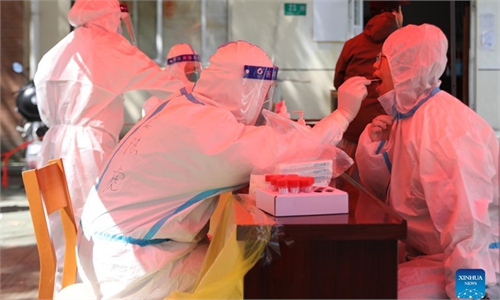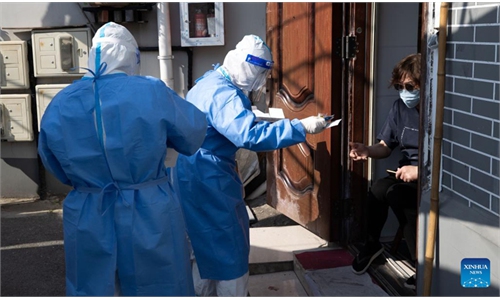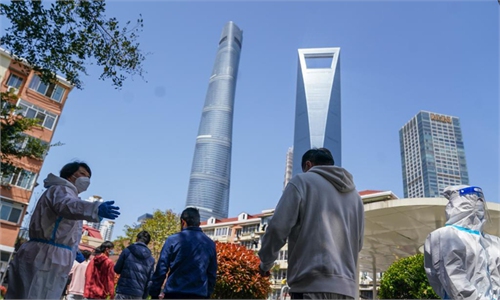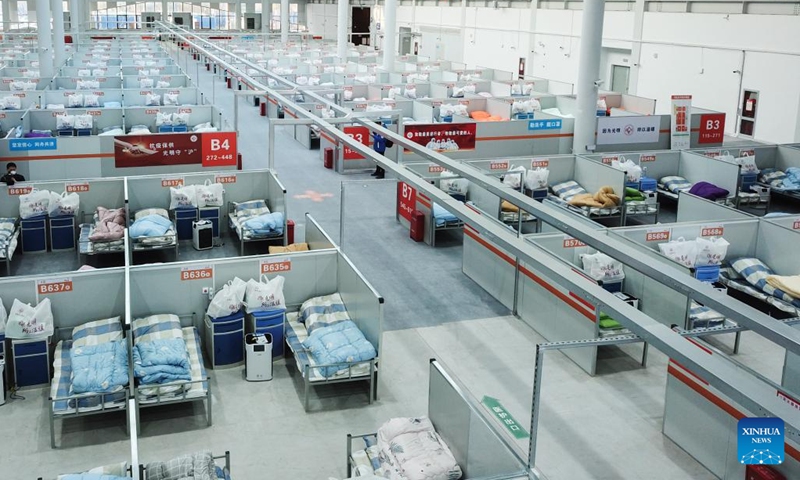
A makeshift hospital in Chongming of Shanghai Photo: Xinhua
Shanghai saw the largest-ever daily increase of infections after testing all its 25 million residents on Monday, with 268 confirmed cases and 13,086 asymptomatic infections, bringing the accumulated number of COVID-19 infections in Shanghai to 73,000 since March.
Chinese Vice Premier Sun Chunlan, after visiting quarantine centers, makeshift hospitals, nucleic acid tests centers and communities, urged the city to adopt stricter attitude, more thorough measures, and swifter actions, to ratchet up building of makeshift hospitals, expand isolation venues, and strictly follow guidelines in order to defeat COVID-19.
Sun said Shanghai is at a crucial point in its fight against the virus, but with the help from other provinces and regions, the city will succeed.
The Vice Premier also asked Shanghai to plug loopholes, guarantee people's life necessities and medical needs, and ensure smooth operation of ports and the supply chain industry.
Shanghai has approximately 47,700 beds for isolation and treatment of COVID-19 patients at present, including those in makeshift hospitals, and an additional 30,000 will be put into use immediately, Gu Honghui, a deputy secretary general of Shanghai Municipal People's Government, said at Tuesday's briefing.
According to Gu, a top task at the moment is to transfer and quarantine positive cases. Once new positive cases are found, they must be transferred immediately and quarantined as soon as possible.
As of Tuesday afternoon, the ward for children who tested positive in Shanghai New International Expo Center, a temporarily makeshift hospital, has received 100 children, with their parents accompanying them. Parents can stay with infected kids at makeshift hospitals, regardless positive or not.
A medical team of 59 medical workers from the Shanghai Children's Medical Center will be responsible for their treatment and medical care, an employee from the Shanghai Children's Medical Center told the Global Times on Tuesday on the condition of anonymity.
The employee told the Global Times that after strict medical evaluation, children with mild and asymptomatic syndromes will be sent to makeshift centers. "Children with tumors, cardiovascular diseases and other underlying diseases will be treated in designated hospitals instead of makeshift centers."
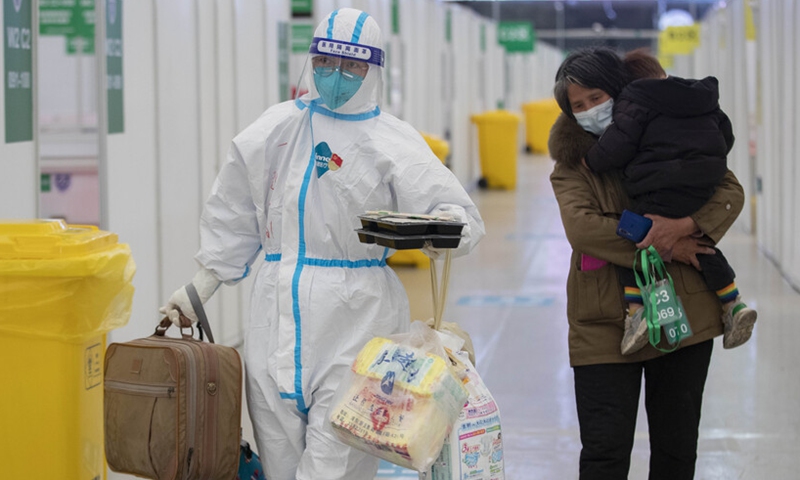
Photo: Shanghai Observer
Several Shanghai residents told the Global Times that once a positive case is detected, he or she will be immediately sent to the collective isolation sites, and those who live with the patients, as well as communities they reside in, will be sealed off for a period of time.
What Shanghai lacks now is isolation venues, not medical resources treating people with severe symptoms, Zhang Wenhong, head of the Shanghai panel overseeing the treatment of COVID-19 said during an interview published on Tuesday. He warned that makeshift hospitals alone are not enough, noting every district, even every community should resort to all available venues for isolating patients.
The Global Times learned that several districts in Shanghai are actively exploring hotels, exhibition centers and other venues to isolate patients.
Wu Qianyu, an official from Shanghai health authorities, said at Tuesday's press briefing that mass testing, which was completed within a day, will help screen all risk points, staunch transmission chain, and play a vital role in stamping out the spread.
"Currently, Shanghai's epidemic prevention and control is at the most difficult and most critical stage," said Wu. "We must adhere to the general policy of dynamic clearance without hesitation, without wavering."
Meanwhile, Shanghai still remains under sealed off management as it reviews results of testing all residents for COVID-19, authorities said on Monday.
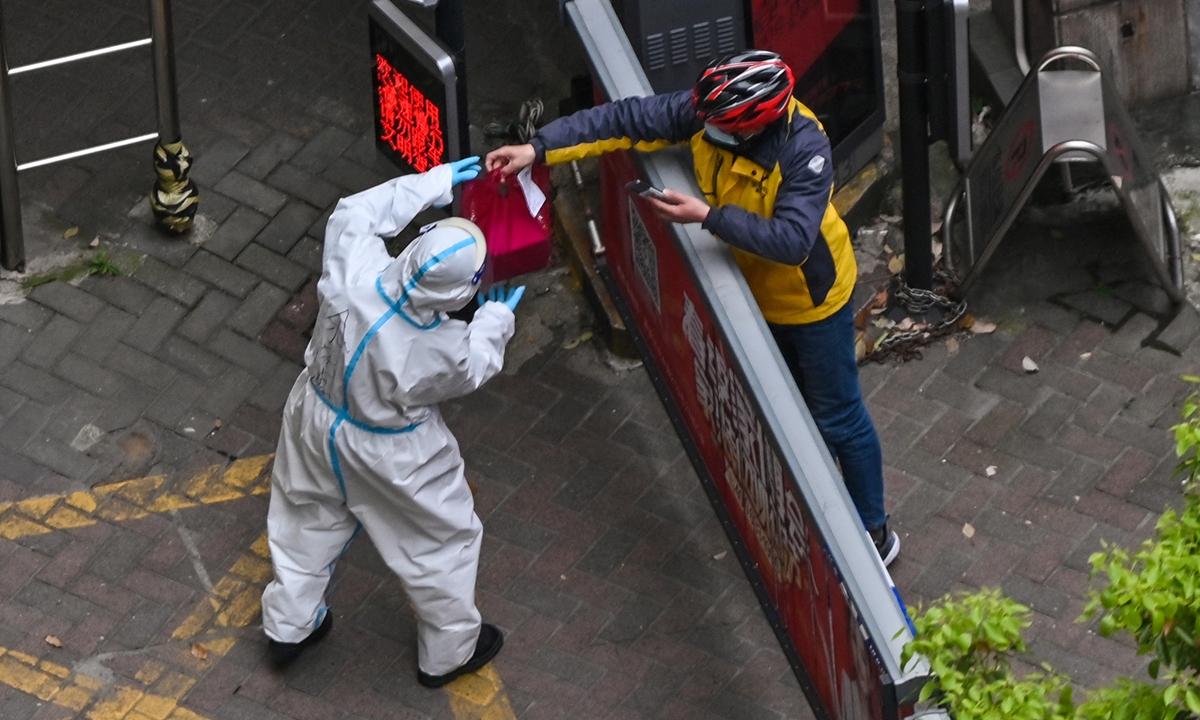
A community worker wearing protective suit receives an item from a deliveryperson at the entrance of a sealed compound in Jing' an district in Shanghai on April 5, 2022. Photo: AFP
To beat virus with support
Medical experts said Shanghai's outbreak, with over 73,000 locally transmitted cases since March, is bigger than what Wuhan faced at the height of the pandemic. Wuhan recorded around 50,000 cases. Despite having more cases, said the experts, Shanghai is in a better position than Wuhan due to improved preparations and accumulated experience.
The Omicron-driven outbreak won't crush Shanghai's medical system but will pose great challenges to Shanghai's medical workers and grassroots officials, as they are engaged in identifying, rounding up and treating patients, said Lu Hongzhou, head of Shenzhen's anti-epidemic expert team and head of the Third People's Hospital of Shenzhen.
Lu believes that the onslaught of Omicron is a lesson for other places to prepare enough isolation sites. If there are enough isolation venues, the transmission chain would be able to be cut off soon, he said.
Yet Chen Xi, an associate professor at the School of Public Health of Yale University, told the Global Times on Tuesday that there's been discussion about allowing asymptomatic patients to quarantine at home. "I think Shanghai could explore this possibility. In fact, the quickly growing number of silent carriers would limit the capacity of medical institutions, exceeding the speed of construction of makeshift hospitals."
Given the surging domestic infections, Chen suggested that the local medical resources should be used for treating those who have an urgent demand while more antigen self-testing kits should be dispatched to households for faster screening.
A medical worker in Shanghai, who required anonymity, told the Global Times that her hospital has been divided into two groups, one group to treat patients in makeshift hospitals and another to go out to administer tests. She said she joined the city-wide test 3 am on Monday, and only finished until 3 am on Tuesday.
Over 38,000 medical workers from 15 provincial-level regions have been deployed to aid Shanghai so far. It's the largest number of nationwide medical aid since Wuhan in early 2020. Nine of the provinces and regions have sent more than 11,000 medical personnel to undertake the task of medical teams in makeshift hospitals, and four provinces have sent medical personnel for nucleic acid sampling.
Similar to what happened in Wuhan in 2020, PLA medical troops have participated in a series of tasks. China's military authorities on Sunday dispatched more than 2,000 medical workers to Shanghai.
Lu believes that the viral infection in Shanghai will be staunched after the potential virus carriers were screened during the past eight days of mass testing, and after another seven-day observation period.
While some Western media is focusing on the "huge cost" of the Shanghai's fight against Omicron, hyping on its "failure of tactics" of controlling the epidemic resurgence, Chinese experts said like Hong Kong, Shanghai will also offer the valuable data sample for China in terms of the efficiency of vaccines, and how they prevent severe cases.
"It's still too early to say whether Shanghai has failed or not, but its experiences sounded the warning shot for other regions and cities, in terms of how to better prepare for the next resurgence," Chen said.
Experts said that Shanghai's current plight again proves that the dynamic zero-COVID policy is the most suitable strategy for China in the current battle with Omicron, as even Shanghai, which is endowed with one of the country's best medical systems, has not yet prepared for shocks of surging numbers of infections. The experts added that China has a relatively low vaccination rate among the elderly.
The top-down support and cross-region assistance to Shanghai can't repeat if China decides to reopen at premature conditions, and faces multiple resurgences in different regions, said Chen, noting that Shanghai rings an alarm bell for the whole country that China still needs time to prepare for easing COVID-19 restrictions in the future.
